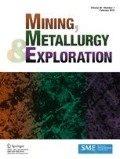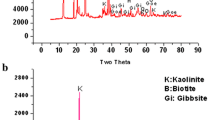Abstract
This study aimed to remove the contaminants in quartz sand by using an eco-friendly method and to obtain high-purity quartz. For this purpose, ultrasound-assisted acid leaching was applied. Equal amounts of a mixture of diluted hydrochloric and oxalic acids were used as the solvent. Response surface methodology (RSM) was used for optimizing, modeling, and predicting the experimental parameters. The correlation coefficient (R2) of the proposed quadratic model for the relationship between iron removal yield and test parameters was calculated as 0.9731 and it was determined that the predicted and actual values were compatible. Finally, optimization experiments were made and optimum experiment conditions were revised and determined as 83.38 °C of leaching temperature, 196.35 min of leaching time, 2.86 M of acid concentration, and 202.24 W of ultrasound power. Under the optimum conditions determined after optimization, the highest yield of iron removal was determined as 95.08%. Under the optimal parameters, the SiO2 content of the concentrates increased from 97.841 to 99.907% and the Fe2O3 content reduced from 0.225 to 0.011%.






Similar content being viewed by others
References
Ariffin KS (2004) What is silica. Mineral Perindustrian EBS 425:1–7
Dal-Martello E, Tranell G, Gaal S, Raaness OS, Tang SK, Arnberg L (2011) Study of pellets and lumps as raw materials in silicon production from quartz and silicon carbide. Metall Mater Trans B 42(B):939–950. https://doi.org/10.1007/s11663-011-9529-y
Haus R, Prinz S, Priess C (2012) Assessment of high purity quartz resources. In: Gotze, Mockel (eds) Quartz: Deposits, mineralogy and analytics. Springer, Berlin pp 29–51. https://doi.org/10.1007/987-3-642-22161-3-2
Suratman S (2015) Removal of metallic impurities from quartz sand using oxalic acid. Indones Min J 18(3):133–141. https://doi.org/10.30556/imj.Vol18.No3.2015.262
Tuncuk A, Akcil A (2016) Iron removal in production of purified quartz by hydrometallurgical process. Int J Miner Process 153:44–50. https://doi.org/10.1016/j.minpro.2016.05.021
Anas-Boussaa S, Kheloufi A, Boutarek-Zaourar N, Bouachma S (2017) Iron and aluminum removal from Algerian silica sand by acid leaching. Acta Phys Pol A 132(3):1082–1086. https://doi.org/10.12693/APhysPolA.132.1082
Yang C, Li S, Bai J, Han S (2018) Advanced purification of industrial quartz using calcination pretreatment combined with ultrasound-assisted leaching. Acta Geodyn Geomater 15(2):187–195. https://doi.org/10.13168/AGG.2018.0014
Zhu J, Dai S, Li P, Yang S (2021) An experimental study of removing impurity from a quartz ore by microbial flotation-acid leaching. Physicochem Probl Miner Process 57(1):18–28. https://doi.org/10.37190/ppmp/128183
Ubaldini SL, Piga L, Fornari P, Massidda R (1996) Removal of iron from quartz sands: a study by column leaching using a complete factorial design. Hydrometallurgy 40:369–379. https://doi.org/10.1016/0304-386X(95)00012-6
Ambikadevi VR, Lalithambika M (2000) Effect of organic acids on ferric iron removal from iron-stained kaolinite. Appl Clay Sci 16:133–145. https://doi.org/10.1016/S0169-1317(99)00038-1
Du F, Li J, Li X, Zhang Z (2011) Improvement of iron removal from silica sand using ultrasound-assisted oxalic acid. Ultrason Sonochem 18:389–393. https://doi.org/10.1016/j.ultsonch.2010.07.006
Zhang ZZ, Li JS, Li XX, Huang HQ, Zhou LF, Xiong TT (2012) High efficiency iron removal from quartz sand using phosphoric acid. Int J Miner Process 114:30–34. https://doi.org/10.1016/j.minpro.2012.09.001
Müller A, Ihlen PM, Wanvik JE, Flem B (2007) High-purity quartz mineralization in kyanite quartzites. Norway Miner Deposita 42(5):523–535. https://doi.org/10.1007/s00126-007-0124-8
Santos MFM, Fujiwara E, Schenkel EA, Enzweiler L, Suzuki CK (2015) Processing of quartz lumps rejected by silicon industry to obtain a raw material for silica glass. Int J Miner Process 135:65–70. https://doi.org/10.1016/j.minpro.2015.02.002
Vatalis KI, Charalambides G, Benetis NP (2015) Market of high purity quartz innovative applications. Procedia Econ Financ 24:734–742. https://doi.org/10.1016/S2212-5671(15)00688-7
Tuncuk A, Akcil A (2014) Removal of iron from quartz ore using different acids: a laboratory-scale reactor study. Min Proc Ext Rev 35(4):217–228. https://doi.org/10.1080/08827508.2013.825614
Li X, Li T, Gao J, Huan H, Li L, Li J (2016) A novel “green” solvent to deeply purify quartz sand with high yields: a case study. J Ind Eng Chem 35:383–387. https://doi.org/10.1016/j.jiec.2016.01.018
Yang C (2018) Advanced purification of industrial quartz using calcination pretreatment combined with ultrasound-assisted leaching. Acta Geodyn Geomater 15(2):187–195. https://doi.org/10.13168/AGG.2018.0014
Yang CQ, Li SQ (2020) Kinetics of iron removal from quartz under ultrasound-assisted leaching. High Temp Mater Processes 39:395–404. https://doi.org/10.1515/htmp-2020-0081
Ambedkar B, Nagarajan R, Jayanti S (2011) Investigation of high-frequency, high-intensity ultrasonics for size reduction and washing of coal in aqueous medium. Ind Eng Chem Res 50(23):13210–13219. https://doi.org/10.1021/ie200222w
Saikia BK, Dutta AM, Saikia L, Ahmed S, Baruah BP (2014) Ultrasonic assisted cleaning of high sulphur Indian coals in water and mixed alkali. Fuel Process Technol 123:107–113. https://doi.org/10.1016/j.fuproc.2014.01.037
Ashokkumar M (2015) Applications of ultrasound in food and bioprocessing. Ultrason Sonochem 25:17–23. https://doi.org/10.1016/j.ultsonch.2014.08.012
Mao Y, Xie G, Liang L, Xia W, Peng Y (2019) Effects of ultrasonic treatment on the particle size, shape and ash content of fine coal. Physicochem Probl Miner Process 55(3):679–688. https://doi.org/10.5277/ppmp18182
Lv W, Chen J, Min F, Hou B, Liu C (2020) Effect of ultrasonic pre-treatment on coal slime flotation. Physicochem Probl Miner Process 56(1):173–183. https://doi.org/10.5277/ppmp19095
Xing P, Wang J, Lyu T, Zhuang Y, Du X, Luo X (2015) Ultrasound-assisted impurity removal from petroleum coke. Sep Purif Technol 151:251–255. https://doi.org/10.1016/j.seppur.2015.07.036
Chang J, Zhang E, Yang C, Zhou J, Peng J, Zhang L, Srinivasakannan C (2016) Kinetics of ultrasound-assisted silver leaching from sintering dust using thiourea. Green Process Synth 5:31–40. https://doi.org/10.1515/gps-2015-0042
Li F, Jiang X, Zuo Q, Li J, Ban B, Chen J (2021) Purification mechanism of quartz sand by combination of microwave heating and ultrasound assisted acid leaching treatment. Silicon 13:531–541. https://doi.org/10.1007/s12633-020-00457-7
Box GEP, Behnken DW (1960) Some new three level design for the study of quantitative variables. Technometrics 2(4):455–475. https://doi.org/10.2307/1266454
Box GEP, Hunter JS, Hunter WG (2005) Statistics for experimenters: design, innovation, and discovery, 2nd edn, Wiley, 672 p
Azizi A, Masdarian M, Hassanzadeh A, Bahri Z, Niedoba T, Surowiak A (2020) Parametric optimization in rougher flotation performance of a sulfidized mixed copper ore. Minerals 10(8):660. https://doi.org/10.3390/min10080660
Gosu V, Arora S, Subbaramaiah V (2020) Simultaneous degradation of nitrogenous heterocyclic compounds by catalytic wet-peroxidation process using Box-Behnken design. Environ Eng Res 25(4):488–497. https://doi.org/10.4491/eer.2019.159
Jamróz D, Niedoba T, Pięta P, Surowiak A (2020) The use of neural networks in combination with evolutionary algorithms to optimize the copper flotation enrichment process. Appl Sci 10(9):3119. https://doi.org/10.3390/app10093119
Peng X, Yang G, Shi Y, Zhou Y, Zhang M, Li S (2020) Box-Behnken design based statistical modeling for the extraction and physicochemical properties of pectin from sunflower heads and the comparison with commercial low-methoxyl pectin. Sci Rep 10:3595. https://doi.org/10.1038/s41598-020-60339-1
Taran M, Aghaie E (2015) Designing and optimization of separation process of iron impurities from kaolin by oxalic acid in bench-scale stirred-tank reactor. Appl Clay Sci 107:109–116. https://doi.org/10.1016/j.clay.2015.01.010
Aslam M, Aqil M, Ahad A, Najmi AK, Sultana Y, Ali A (2016) Application of Box-Behnken design for preparation of glibenclamide loaded lipid-based nanoparticles: optimization, in vitro skin permeation, drug release and in vivo pharmacokinetic study. J Mol Liq 219:897–908. https://doi.org/10.1016/j.molliq.2016.03.069
El-Sayed MA, Fathy WM, Salleh AM, Moharam MR, Ibrahim SS (2018) Processing of Wadi Qena kaolinitic white sands by selective dispersion and leaching for industrial uses. J Al-Azhar Uni Eng Sec 13(47):530–545. https://doi.org/10.21608/AUEJ.2018.19059
Polat S, Sayan P (2019) Application of response surface methodology with a Box-Behnken design for struvite precipitation. Adv Powder Technol 30:2396–2407. https://doi.org/10.1016/j.apt.2019.07.022
Agacayak T, Ahmed MT (2020) Optimization and modeling of leaching parameters affecting nickel dissolution from lateritic ore in Eskisehir (Mihaliccik-Yunusemre) using Box-Behnken experimental design. J Environ Anal Chem 7(1):1–7. https://doi.org/10.37421/jreac.2020.7.263
Shahraki S, Karamoozian M, Azizi A (2018) Desulfurization of coal by HNO3 leaching: optimization of influential factors using Box-Behnken design. J Min Environ 9(3):657–665. https://doi.org/10.22044/JME.2018.6338.1457
Hassan MZ, Roslan SA, Sapuan SM, Rasid ZA, Mohd-Nor AF, Md-Daud MY, Dolah R, Yusoff MMZ (2020) Mercerization optimization of bamboo (bambusa vulgaris) fiber-reinforced epoxy composite structures using a Box-Behnken design. Polymers 12:1367. https://doi.org/10.3390/polym12061367
Ye G, Ma L, Li L, Liu J, Yuan S, Huang G (2017) Application of Box-Behnken design and response surface methodology for modeling and optimization of batch flotation of coal. Int J Coal Prep Util 40(2):131–145. https://doi.org/10.1080/19392699.2017.1350657
Imron MF, Titah HS (2018) Optimization of diesel biodegradation by Vibrio alginolyticus using Box-Behnken design. Environ Eng Res 23(4):374–382. https://doi.org/10.4491/eer.2018.015
Joglekar A, May A (1987) Product excellence through design of experiments. Cereal Foods World 32:857–868
Oney O (2018) Optimization of operating parameters of graphite flotation circuit using Box-Behnken design. Indian J Chem Technol 25(2):170–178
Altiner M (2019) Recovery of apatite from ore slimes using centrifugal heavy liquid separation. J Mater 71:3202–3208. https://doi.org/10.1007/s11837-019-03591-9
Hao C, Chu M, Wang L, Zhou L (2020) The effect of preparation conditions on microbubble flotation process of ultra clean coal using Box-Behnken design model. Chemistry Select 5:1767–1775. https://doi.org/10.1002/slct.201902447
Ipeksever S, Gönen M (2020) Optimization of boric acid extraction from ulexite mineral by using supercritical carbon dioxide. J Supercrit Fluids 166:104998. https://doi.org/10.1016/j.supflu.2020.104998
Maran PJ, Manikandan S, Thirugnanasambandham K, Nivetha VC, Dinesh R (2013) Box-Behnken design based statistical modeling for ultrasound-assisted extraction of corn silk polysaccharide. Carbohydr Polym 92:604–611. https://doi.org/10.1016/j.carbpol.2012.09.020
Qiu P, Cui M, Kang K, Park B, Son Y, Khim E, Jang M, Khim J (2014) Application of Box-Behnken design with response surface methodology for modeling and optimizing ultrasonic oxidation of arsenite with H2O2. Open Chem 12:164–172. https://doi.org/10.2478/s11532-013-0360-y
Manzato L, Takeno ML, Pessoa-Junior WAG, Mariuba LAM, Simonsen J (2018) Optimization of cellulose extraction from jute fiber by Box-Behnken design. Fibers Polym 19:289–296. https://doi.org/10.1007/s12221-018-1123-8
Acknowledgements
The author is grateful to the General Directorate of Mineral Research and Exploration Analysis Laboratory and Cukurova University Central Research Laboratory for all analyses.
Author information
Authors and Affiliations
Corresponding author
Ethics declarations
Ethical Approval
This article does not contain any studies with human participants or animals performed.
Conflict of Interest
The author declares no competing interests.
Additional information
Publisher's Note
Springer Nature remains neutral with regard to jurisdictional claims in published maps and institutional affiliations.
Rights and permissions
About this article
Cite this article
Arslan, V. The Modeling and Optimization of Iron Removal from Silica Sand Under Ultrasound-Assisted Leaching by Response Surface Methodology . Mining, Metallurgy & Exploration 38, 2229–2237 (2021). https://doi.org/10.1007/s42461-021-00457-0
Received:
Accepted:
Published:
Issue Date:
DOI: https://doi.org/10.1007/s42461-021-00457-0




